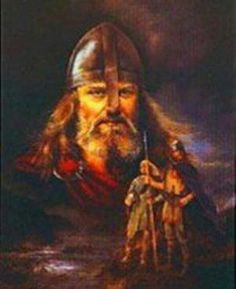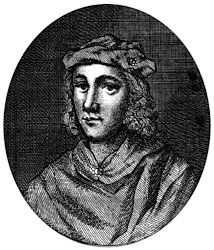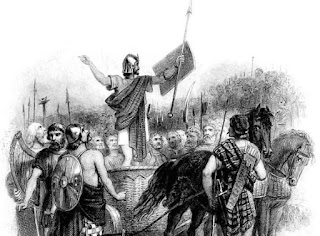Mary Queen of Scots { Part 1 of 2 }
Mary, 1542-1554. Arran's Regency.
(Part 1 of 2)
James Hamilton, Earl of Arran, next heir to the throne by his descent from James the Second, was chosen Regent, but, as it was the Scots custom that the nearest of kin on the mother's side should have the care of the minor, the infant Queen was left in charge of her mother, Mary of Lorraine. The defeat at Solway Moss, and the death of the King, had left the people nearly as dispirited and defenceless as they had been after Flodden, and Henry the Eighth determined to get the kingdom into his power by marrying Mary to his son Edward, Prince of Wales.
To carry out his plans the better, he sent Angus back to Scotland, and with him the Lords Cassilis and Glencairn, and several other nobles, all pledged to do their best to place the Queen and the strongholds in the hands of Henry. These nobles were called by the English the Assured Scots, because Henry thought he could be sure of their help, but they were either unable or unwilling to give him the aid for which he had hoped. It was not till July in the next year that two treaties were drawn up at London: the one for the English alliance; the other agreeing to the English marriage of the Queen. But there was a strong national party, much set against any dealings with England; and, though the treaties were approved at one meeting of the Estates, it was plain that they would be thrown out at the next. The Regent tried to break them off, and Henry, greatly enraged, made [Pg 90]ready for war and seized some Scots ships which had been driven by bad weather into English ports. This was reason enough for the rejection of the treaties by the Estates. Shortly after, the "Assured Scots" changed sides and made a bond with the Regent; but Henry got a new supporter in Matthew Stewart, Earl of Lennox, who, as he wished to marry Margaret Douglas, daughter of Angus, Henry's niece and ward, was eager to do anything to win Henry's favour.
War was declared at Edinburgh by an English herald, May 1, 1544, and an English army under Edward Seymour, Earl of Hertford, was sent by sea and landed at Granton. He was tasked to destroy Edinburgh and as many other towns and villages as he conveniently could, and he carried out his orders to the letter. He sacked and burned Leith, a wealthy trading town, set fire to Edinburgh, though no resistance had been made to him there, robbed the burghs on the coast of Fife, and then marched south to the Border, burning, slaying, spoiling, and leaving a wasted land behind him. The only resistance he met with was near the Border, where a division of his army which had been sent to Melrose to break open the tombs of the ancestors of Angus was routed at Ancrum by Angus himself and some of the Border lords. At the news of this success six hundred Borderers from the Scottish side, who had been fighting in the service of the English Wardens, changed sides and attacked their former brothers in arms. The rest of the nation then took heart, and a large force was mustered and brought to the Border but did nothing.
Before the traces of his former ravages had disappeared, just when the next harvest was ready for the sickle, Hertford appeared again at the head of a motley host, swelled by the Irish and by foreign hired soldiers, and repeated the wild work of the year before. The [Pg 91]invaders attacked and plundered the religious houses.
The ruins of Kelso, Melrose, Dryburgh, Roxburgh, and Coldingham still bear witness to their zeal in carrying out the orders of their master. Towns, manors, churches, and between two and three hundred villages were left in ashes behind them. All this misery was wantonly inflicted without winning for Henry a foot of ground or a single new subject.
Two years passed, and again the sorely scourged country was visited by its old enemy. Hertford, now Duke of Somerset and Protector of England during the minority of Edward the Sixth, thought by one well-aimed blow to remove from the people their proud boast, the national independence.
Two armies, the one led by himself and the other sent by sea, met at Musselburgh and threatened the capital. The Regent had mustered a large force to resist them, and the two hosts faced each other on opposite banks of the Esk. But the Scots very foolishly left their strong position and forced the English to a battle, in which they were again defeated with great slaughter, at Pinkie, September 10, 1547. After the battle Somerset went back to England and took the greater part of his army with him. As most of the strongholds were now in the hands of the English, it was thought best to send the Queen to France that she might be out of harm's way. The French sent six thousand men to help in driving out the English, a work that was not ended till 1550, when a short peace followed the nine years of cruel war. If we consider the difference of the times and the advance of civilization, the fiercest raids of Malcolm and of Wallace may be favourably compared with the misery wrought by Hertford in these three savage and unprovoked attacks.
The overthrow of the monasteries, the seizure of their revenues, and the other changes in religious matters carried out by Henry the Eighth in England, [Pg 92]had been approved by a large party in Scotland. They were eager to begin the same work there, for the Church, by her abuse of power and by her persecution of all who differed from her, was fast losing her hold upon the people. The first outbreak of the popular feeling was the murder of Cardinal David Beaton, the Primate, the leader of the French party in the state and the chief mover of religious persecution. In revenge for the burning of George Wishart in 1545, for preaching what was called heresy, sixteen of Wishart's followers murdered Beaton in his own Castle of St. Andrews, which they had entered by a stratagem, and which they held for fourteen months, setting at defiance all the Regent's efforts to retake it. It was only with the help of the French that they were at last obliged to give in and were sent to the French galleys. Among them was John Knox, who twelve years later became famous as the apostle of the Reformation among his countrymen. On the death of Beaton, Arran made his own ambitious brother John Archbishop of St. Andrews, in the room of the murdered Cardinal. The castle was destroyed.
End of part 1
_-_Google_Art_Project.jpg)












Comments
Post a Comment